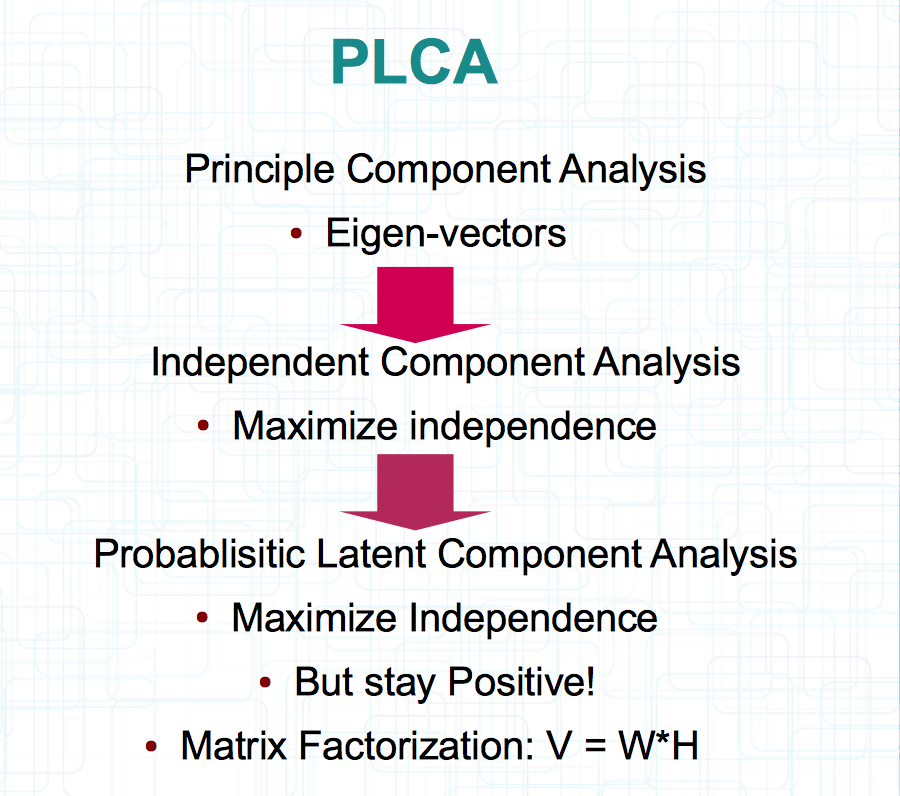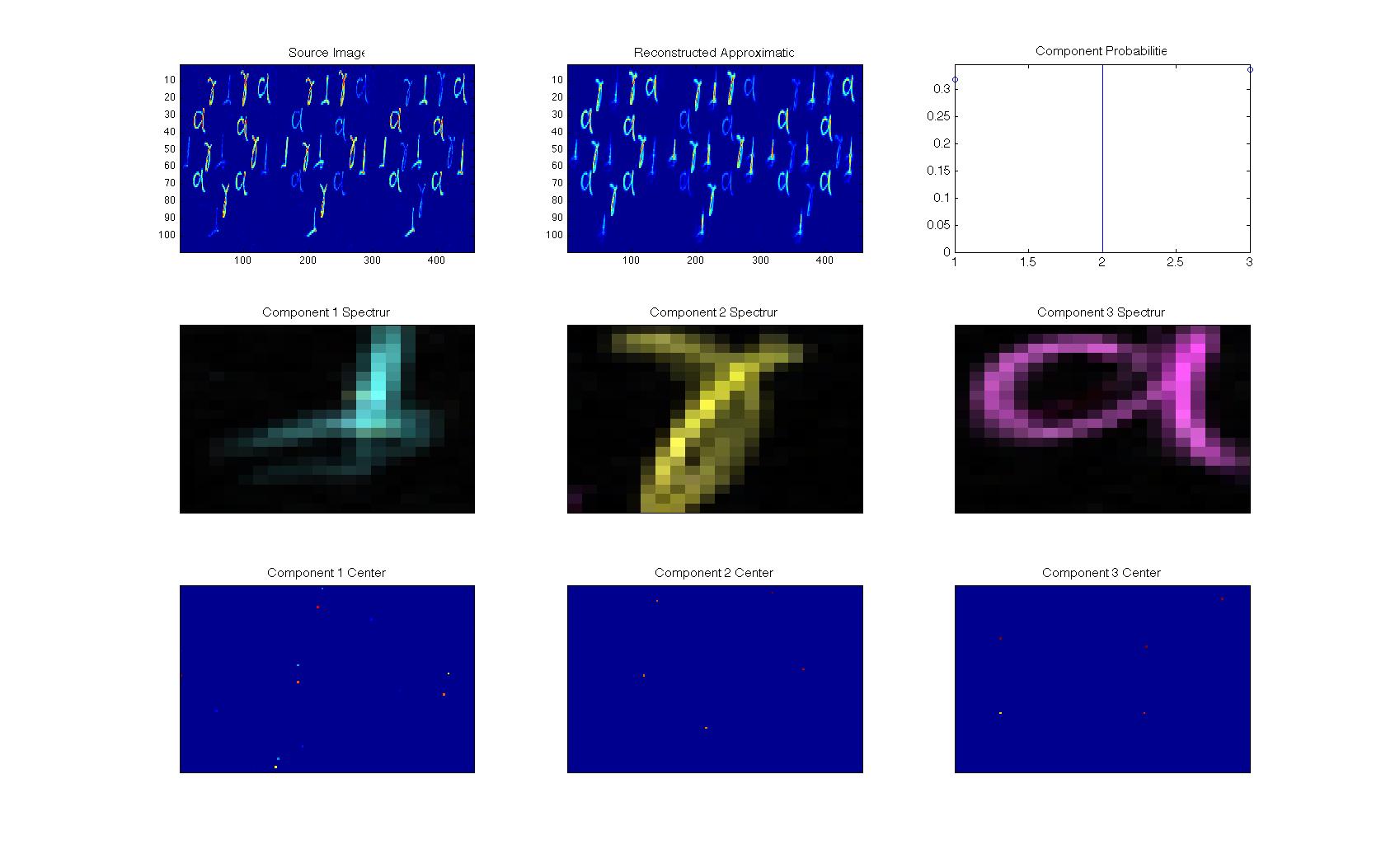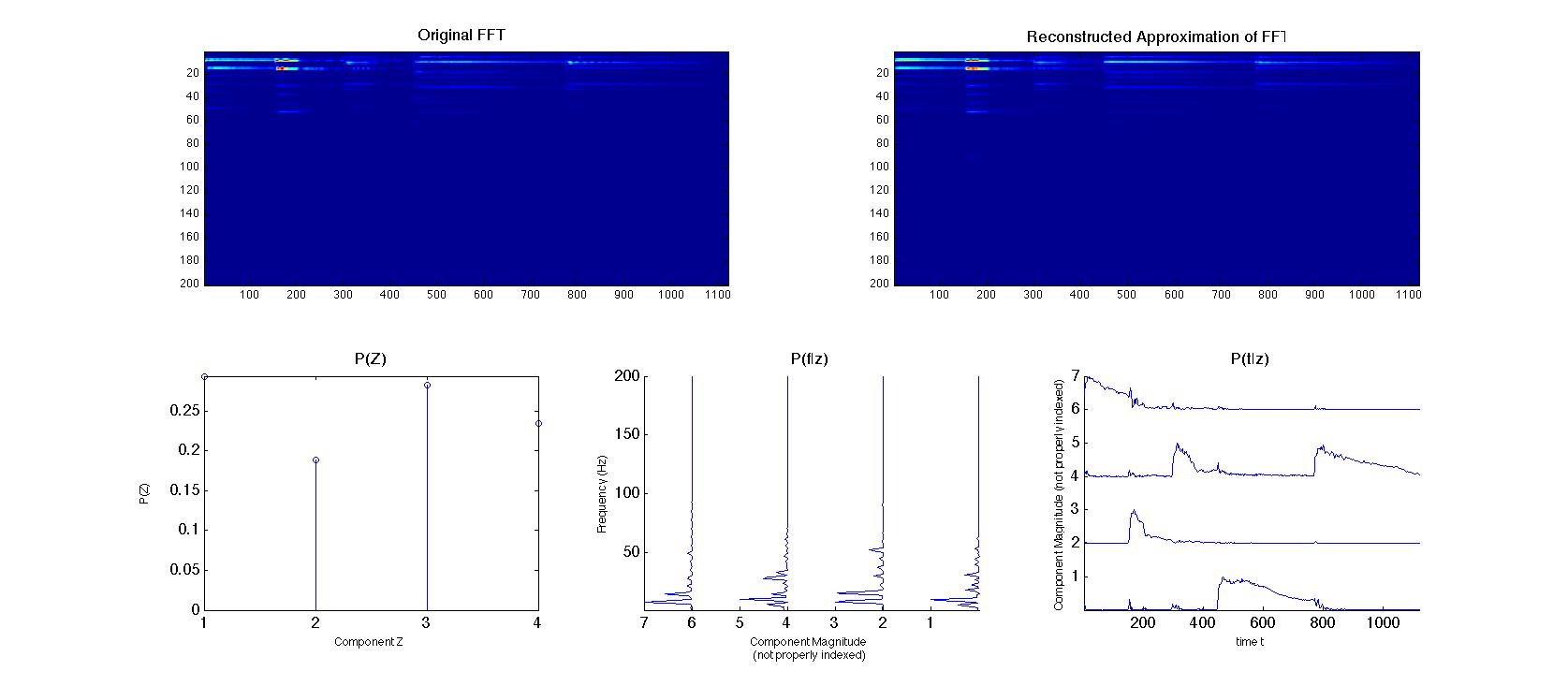Probabilistic
Latent Component Analysis
This
work has been primarily based off two papers by Paris Smaragdis,
“Shift-Invariant Probabilistic Latent Component Analysis”
(Smaragdis & Raj 2007) and “Separation by “humming”:
User-guided sound extraction from monophonic mixtures” (Smaragdis &
Mysore 2009). Please visit his web-page
and give them a read if you want to know more. They are good reads.
 Some
of the earliest work in audio separation and extraction was done
using Principle Component Analysis, maximizing component variance.
Subsequently, Independent Component Analysis, targeting components of
maximal independence became dominant for finding latent components.
But ICA decomposition yields results that are statistically but not
necessarily interpretable. For instance, ICA will find components
with negative vectors. With the example of audio, there are no
negative frequencies so these decompositions are unintuitive.
Some
of the earliest work in audio separation and extraction was done
using Principle Component Analysis, maximizing component variance.
Subsequently, Independent Component Analysis, targeting components of
maximal independence became dominant for finding latent components.
But ICA decomposition yields results that are statistically but not
necessarily interpretable. For instance, ICA will find components
with negative vectors. With the example of audio, there are no
negative frequencies so these decompositions are unintuitive.
PLCA
is a form of Non-Negative Matrix Factorization that looks to maximize
independence similarly to ICA, but forces the results to be positive
yielding understandable results. PLCA is an Expectation-Maximization
algorithm that models a mixture of independent distributions. Each
distribution is considered an independent component, z, latent within
the data. The idea is to discover what these latent components and
where are they.
Here’s
a more complex but easily understandable example provided from
Smaragdis’s work:

Looking
at the initial image, it is possible to see that there are three main
shapes. These are identified as components with 3 main properties.
The mixture distributions itself shown in the second row. The bottom
row displays the discovered centers of these mixtures while the third
image in the top row relates the probability of each of these three
components occuring. Multiplying (or convolving in this case) the
three component properties together results in an approximation of
the original image. Each component will be an average of the similar
originals. The algorithm is standard EM in that in the estimation
stage, it calculates the contribution of each component to the sum
spectrum and in the maximization the three components property
marginals are re-weighted. For the actual detailed math, please refer
to the referenced papers.
Audio
is a 2-D PLCA example. The first step is to switch to the fourier
domain and use the frequency spectrum for decomposition. Here the
component z is the spectral content of a specific note event or
sound. It is decomposed into three properties: the spectral signature
p(f|z), the magnitude over time p(t|z) and the component likely hood
p(z). This is demonstrated below:

The
example used in this case is a five event, four note pattern on the
piano. The three graphs can be easily understood to depict the
frequency spectrum generated by each note, the times at which those
notes sound, and the overall probability of each.
One
of the unknowns in the algorithm is how many components or notes a
sample has. In both these examples, we've known and can specify
appropriately. A slightly different version of the above is run
requesting five components. This time the algorithm is run to find 5
components:

It
is relatively easy to discern that the 2nd component is an
conglomeration of the other 4 components and not actually very
informational. In separation, this is mildly problematic but
discoverable. In extraction it introduces more possibility for error.
Next-
Extraction Using PLCA & Mimicry
 Some
of the earliest work in audio separation and extraction was done
using Principle Component Analysis, maximizing component variance.
Subsequently, Independent Component Analysis, targeting components of
maximal independence became dominant for finding latent components.
But ICA decomposition yields results that are statistically but not
necessarily interpretable. For instance, ICA will find components
with negative vectors. With the example of audio, there are no
negative frequencies so these decompositions are unintuitive.
Some
of the earliest work in audio separation and extraction was done
using Principle Component Analysis, maximizing component variance.
Subsequently, Independent Component Analysis, targeting components of
maximal independence became dominant for finding latent components.
But ICA decomposition yields results that are statistically but not
necessarily interpretable. For instance, ICA will find components
with negative vectors. With the example of audio, there are no
negative frequencies so these decompositions are unintuitive.


